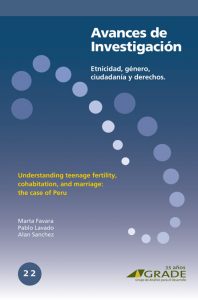Understanding teenage fertility, cohabitation, and marriage: the case of Peru
| Year | : | 2016 |
|---|---|---|
| Author/s | : | Marta Favara, Pablo Lavado, Alan Sanchez |
| Area/s | : | Ethnicity, gender and citizenship |
Favara, Marta; Lavado, Pablo y Alan Sanchez (2016). Understanding teenage fertility, cohabitation, and marriage: the case of Peru. Lima: GRADE. Avances de Investigación, 22.
In this study, the authors used data from the Young Lives study, which investigates teenage childbearing, marriage, and cohabitation by tracking a cohort of individuals from the ages of 8 to 19 years. While the present analysis does not intend to establish causality, the longitudinal nature of the data allows the researchers to identify the combination of early circumstances and life changes that induce a higher likelihood of these events. The analysis addresses bias due both to reverse causality and to community characteristics that are usually unobserved and fixed over time, a strategy that is quite unique in studies of developing countries.
About 1 out of 5 females (and 1 out of 20 males) in our sample had at least one child by the age of 19, and 80 percent of them were married or cohabiting. Early marriage/cohabitation is indeed intrinsically related to early pregnancy and largely predicted by the same factors. For females specifically, girls from poor households with an absent parent for a prolonged period have a higher risk of early childbearing. Similarly, girls whose self-efficacy and educational aspirations decrease over time are more at risk of becoming a mother during adolescence. Conversely, school attendance and better school performance predict a lower risk of early pregnancy; the analysis suggests that this is largely because it postpones the first sexual relationship.






